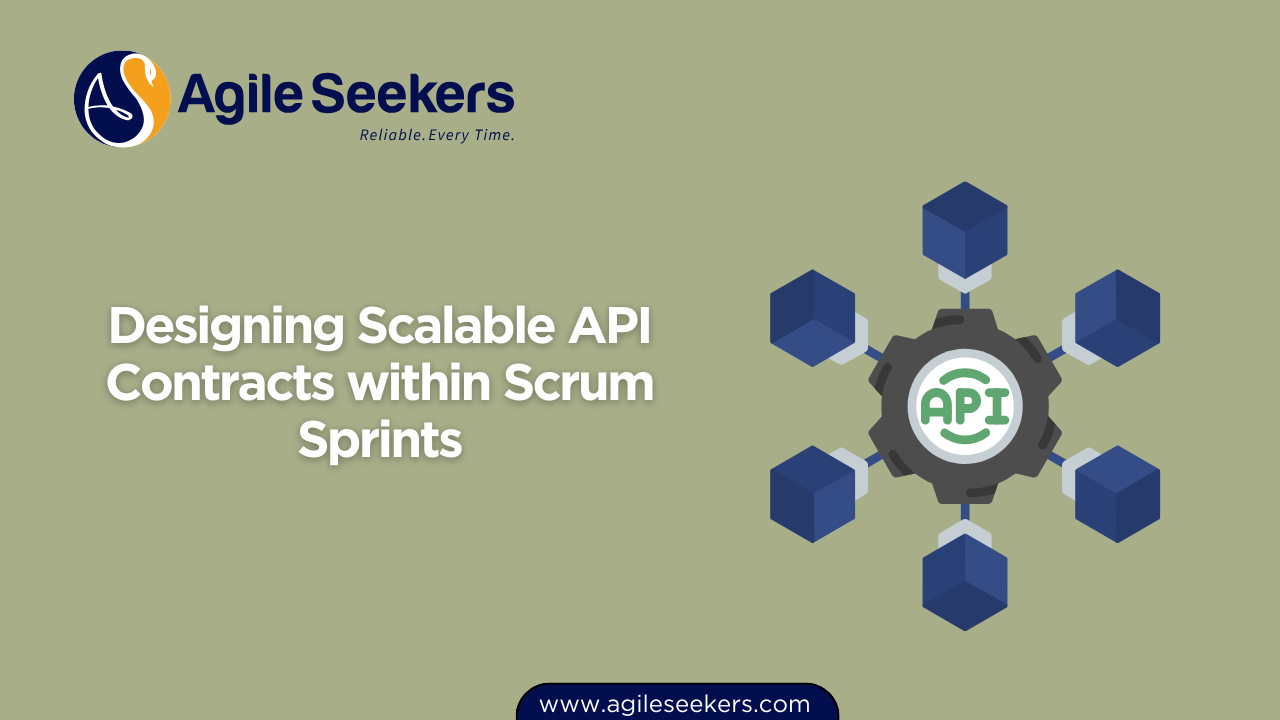Designing Scalable API Contracts within Scrum Sprints

In product development, APIs are no longer just technical interfaces—they are business enablers. For Scrum teams, designing scalable API contracts within a sprint can be challenging, especially when multiple teams consume the same interface or when business needs evolve rapidly. This post explores how to embed effective API contract design into the rhythm of Scrum without compromising agility or scalability.
What Are API Contracts?
An API contract defines the interaction between services—what data is expected, in what format, and under what rules. It acts as a shared agreement between producers and consumers. In modern systems, APIs serve as the glue between microservices, mobile apps, third-party integrators, and core business logic.
A scalable API contract ensures:
- Stability for downstream systems
- Flexibility for future enhancements
- Traceability and governance for compliance
But in Scrum, where delivery happens incrementally, how do you design APIs that don't become technical debt as the product grows?
Challenges of API Contract Design in Scrum
| Challenge | Impact on Scrum Teams |
|---|---|
| Front-end blocked by back-end | Delayed UI development and integration |
| Changing requirements mid-sprint | Rework and broken contracts |
| Tight sprint timelines | Lack of time to model future-proof interfaces |
| Lack of stakeholder visibility | Inconsistent expectations between teams |
| Inadequate contract testing | Fragile integrations and poor versioning strategies |
Best Practices for Designing Scalable APIs in Scrum
1. Involve API Design in Backlog Refinement
API requirements often emerge during backlog grooming. Involve architects and cross-functional stakeholders in refinement sessions. Encourage early discussions on data structures, usage patterns, and dependencies.
This also aligns with practices taught in Certified Scrum Master training, where cross-team collaboration is emphasized during backlog refinement and sprint planning.
2. Shift API Design Left with Consumer-Driven Contracts
Use consumer-driven contract testing tools like Pact or Spring Cloud Contract. This helps each consumer define what they expect from the provider’s API, ensuring that the producer meets real-world usage needs.
3. Model Contracts as Code with OpenAPI
Scrum teams can use tools like Swagger/OpenAPI to treat contracts as version-controlled assets. Developers, testers, and product owners can all review the contract collaboratively.
Version-controlled contracts improve transparency—an important practice highlighted in SAFe Scrum Master training.
4. Split API Work Across Stories
Instead of treating the API as a one-time deliverable, spread its design and validation across multiple backlog items:
- Story 1: Define contract using OpenAPI
- Story 2: Build stubs/mock responses for frontend
- Story 3: Implement and test endpoint
- Story 4: Integrate and validate with consumers
5. Use Feature Toggles for Contract Evolution
When adding fields or changing behavior, use feature flags to control the rollout. This approach supports incremental delivery without breaking existing consumers.
6. Apply Versioning Discipline
Scrum teams often overlook API versioning until it's too late. Define rules early:
- Prefer non-breaking changes within the same version
- Use semantic versioning for public APIs
- Document deprecated endpoints clearly and assign deprecation timelines
This is especially relevant when dealing with multiple Agile Release Trains (ARTs), a concept addressed in SAFe Scrum Master certification.
Embedding Contract Design into Sprint Activities
| Scrum Event | API Design Integration Tip |
|---|---|
| Sprint Planning | Define if new APIs or changes are part of Definition of Done |
| Daily Scrum | Raise early blockers from contract ambiguity |
| Sprint Review | Demo contract interactions via Swagger or Postman |
| Sprint Retrospective | Reflect on any contract-related delays or misunderstandings |
Documentation & Visibility
A scalable API is only as good as its documentation. Use tools like Stoplight, Redoc, or Postman to generate and share documentation automatically from OpenAPI specs.
Definition of Done for API Contracts
To prevent incomplete API implementations from leaking into production, enhance your Definition of Done with clear API standards:
- Contract defined using OpenAPI 3.x
- Reviewed by both producer and consumer teams
- JSON schema validated and linted
- Stubs/mocks available for consumers
- Functional and contract tests automated
- Backward compatibility verified
- Documentation published and versionedThis reflects quality expectations taught in CSM certification training.
Tooling Ecosystem to Support API Lifecycle
| Area | Recommended Tools |
|---|---|
| Contract Definition | Swagger, Postman, Stoplight |
| Contract Testing | Pact, Spring Cloud Contract |
| Mocking/Stubbing | WireMock, Mockoon |
| Versioning & Documentation | Redoc, Spectacle, GitHub Pages |
| Governance & Review | API Linter, Spectral, Commit Hooks |
Final Thoughts
Designing scalable API contracts during Scrum sprints requires forethought, discipline, and collaboration. Teams that treat contracts as living documentation, involve consumers early, and embed contract-related tasks into sprints achieve faster feedback, fewer bugs, and better alignment across systems.
Whether you're new to Agile or looking to enhance delivery in complex enterprise environments, investing in API design maturity helps you deliver stable and adaptable digital services.
Explore how professional training like CSM certification or SAFe Scrum Master training can deepen your understanding of Scrum practices that support technical excellence.
Also read - Applying Scrum for Microservices-Based Architecture Projects
Also see - Managing Environment Configuration and Secrets in Scrum Projects




















